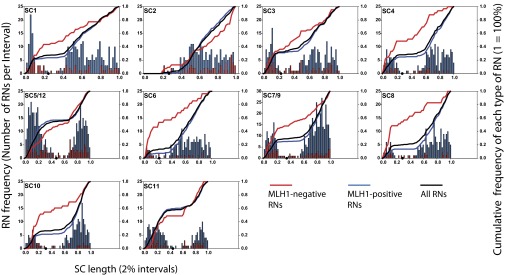Fig. 2.

Distributions of MLH1-positive RNs (blue bars) and MLH1-negative RNs (red bars) for all tomato chromosomes and chromosome groups. Histogram bars are in 2% SC length intervals (X-axis) and show the number of RNs observed per interval (left y axis). The red histogram has been superimposed on the blue histogram for each chromosome. To highlight differences between the individual histograms, lines showing the cumulative frequency (right y axis) of all RNs (black), of MLH1-positive RNs (blue), and of MLH1-negative RNs (red) have been added. The length of each chromosome has been scaled to represent its appropriate length relative to the other chromosomes. The short arm of chromosome 2 is entirely heterochromatic, and the distal segment is usually asynapsed and/or broken off (and often lost) in SC spreads, explaining the lack of any RNs in that region. Only MLH1-negative RNs were observed on the retained short arm of chromosome 2. Except for the near-metacentric chromosomes 5/12 and 11, all chromosomes have a higher fraction of MLH1-negative RNs on the short arm and in the pericentric heterochromatin compared with MLH1-positive RNs (SI Appendix, Table S6). Black dots on the X-axis represent centromere positions.
